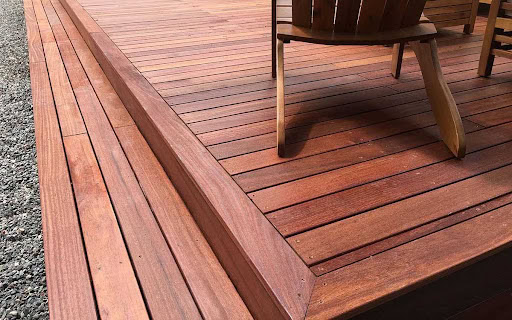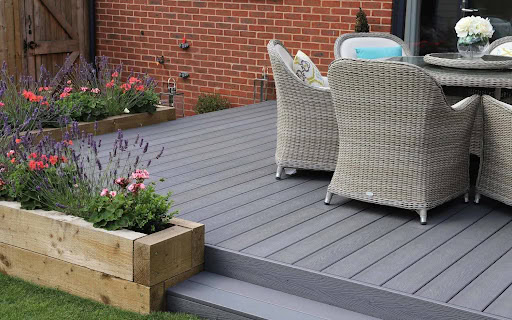PVC vs. Wood vs. Composite: Pros and Cons of the Three Most Popular Deck Materials
When it comes to building or upgrading your outdoor space, choosing the right decking material is essential. Ultimately, it is going to come down to a few important factors: how much you’re willing to spend, the type of design you want, and how long you plan on using the deck
Three popular options dominate the market: PVC (Polyvinyl Chloride), Wood (typically pressure-treated or hardwood), and Composite materials. Like any product, each decking material has its own set of benefits and challenges.
When it comes to deciding between similar products, like this case, we understand how difficult the decision can be. You may not know what exactly the differences are. That is where we step in. At Royal Pools G2 Landscaping, we love educating buyers on all things pools and landscaping, and in this article, we’ll break down the pros and cons of each to help you make an informed decision.
1. PVC

Polyvinyl chloride decking is a thermoplastic polymer material. It is designed to mimic the look of wood while offering superior durability, and significantly less maintenance required by you the homeowner.
PVC Pros:
- Durability: PVC decking is incredibly resistant to moisture, rot, and insects. It doesn’t absorb water, making it an excellent choice for humid climates or areas with frequent rain.
- Low Maintenance: Unlike wood, PVC decking requires minimal upkeep. No staining, sealing, or painting is necessary. Simply wash it with soap and water to keep it looking new.
- Color Options: PVC decks are available in various colors and finishes. They maintain their color over time without fading or discoloring as much as wood or composite.
- Long Lifespan: PVC decking is known for its longevity, lasting up to 50 years. PVC decks typically come with warranties of 25 years or more. It’s highly resistant to fading, staining, and mold growth.
- Eco-Friendly Options: Some brands offer recyclable PVC decking materials, making it a greener choice for environmentally conscious homeowners.
PVC Cons:
- Aesthetic Appeal: While modern PVC decking has improved in appearance, it can still look less natural than wood. Some people find it to be too uniform or artificial in texture.
- Cost: PVC decking can be more expensive upfront compared to traditional wood, though its low maintenance costs can offset the initial price over time.
- Heat Retention: PVC can absorb heat, making it quite hot underfoot on sunny days. This can be uncomfortable in warmer climates.
2. Wood

Wood has been the traditional choice for decking for centuries due to its natural beauty and adaptability. Common types of wood used for decking include pressure-treated pine, cedar, redwood, and tropical hardwoods like ipe and tigerwood.
Wood Pros:
- Natural Look: There’s no denying the timeless appeal of wood. It offers a warm, organic feel that is difficult to replicate with other materials. The grain, texture, and color of the wood give it a unique beauty.
- Versatility: Wood can be stained, painted, or left natural, allowing for a broad range of customization. You can adjust the look over time with new finishes.
- Affordable: Pressure-treated lumber, the most common wood option, is often the most cost-effective choice up front. It can be a great option if you’re on a budget.
- Availability: Wood is widely available and comes in a variety of species, such as cedar, redwood, and pine, each with its own distinct characteristics.
Wood Cons:
- High Maintenance: Wood decks require regular maintenance to keep them in good shape. This includes annual staining, sealing, and cleaning to protect them from rot, mildew, and weathering.
- Susceptible to Damage: Wood is prone to warping, splintering, and cracking, especially in extreme weather conditions. It also tends to fade and discolor over time.
- Environmental Impact: Some types of wood, particularly tropical hardwoods, come from unsustainable sources, contributing to deforestation. Look for FSC-certified wood if you’re concerned about environmental impact.
- Shorter Lifespan: While treated wood can last a decade or more with proper care, its lifespan still tends to be shorter than PVC or composite decking.
3. Composite

Composite deck boards are comprised of a blend of wood fibers and plastic. It is engineered to be highly durable while maintaining a more natural wood look than PVC.
Composite Pros:
- Low Maintenance: Composite decking combines wood fibers and plastic, creating a material that’s resistant to rot, insects, and moisture without the need for frequent staining or sealing.
- Durability: Composite decks are known for their strength and long lifespan. They’re not as prone to splintering or cracking as wood, and they’re resistant to fading and staining.
- Eco-Friendly: Many composite decking materials are made from recycled wood and plastic, making them a more environmentally friendly choice. They help reduce waste and require fewer resources to manufacture than virgin plastics.
- Aesthetic Variety: Composite decking mimics the look of wood but with more consistency in color and texture. You can find composites in a variety of finishes, and many newer products even feature a realistic wood grain.
- Slip-Resistant: Many composite boards are designed with slip-resistant textures, making them a safer option for wet conditions or around pools.
Composite Cons:
- Cost: Composite decking typically costs more than pressure-treated wood, though it may be less expensive than high-end PVC.
- Appearance: While composite decks look like wood, some people still feel they don’t have the same charm or authenticity as natural wood. Early versions of composite decking were criticized for looking too artificial, although newer versions have improved considerably.
- Expansion/Contraction: Some composite materials expand and contract with temperature changes. This can cause gaps or unevenness over time if not properly installed.
Final Comparison and Recommendation
| Feature | PVC | Wood | Composite |
| Durability | 25-50 years (very durable) | 10-50 years (varies by type) | 25-30 years (durable) |
| Maintenance | Low | High | Low |
| Aesthetic | Artificial, many colors | Natural beauty | More natural than PVC |
| Cost | $$$$$$ | $$ | $$$$ |
| Eco-Friendly | Least environmentally friendly | Biodegradable (if untreated) | Often made with recycled materials |
| Installation | Easy, but expands/contracts | Moderate (requires staining/sealing) | Heavy and highly flexible boards require significant attention. |
Which One Should You Choose?
- If you want a natural look at a low cost and are willing to put in maintenance effort, wood is a great option.
- If you prefer low maintenance and high durability, PVC might be the best fit.
- If you want a balance of durability, aesthetics, and lower maintenance, composite decking offers a great middle ground.
Each material has its strengths and weaknesses. We’ve given you a lot of factors to consider here including budget, climate, maintenance preference, cost, and environmental impact. Whatever you choose, investing in quality materials and thoroughly researching and picking the best contractor in your area will ensure your deck remains a beautiful outdoor space for years to come.
Are you curious about which landscape additions will be popular in 2025? If you are check out the article below. If you have more questions regarding decking materials, or any questions regarding pools and landscaping, check out our learning center for educational videos and more articles like this one.
